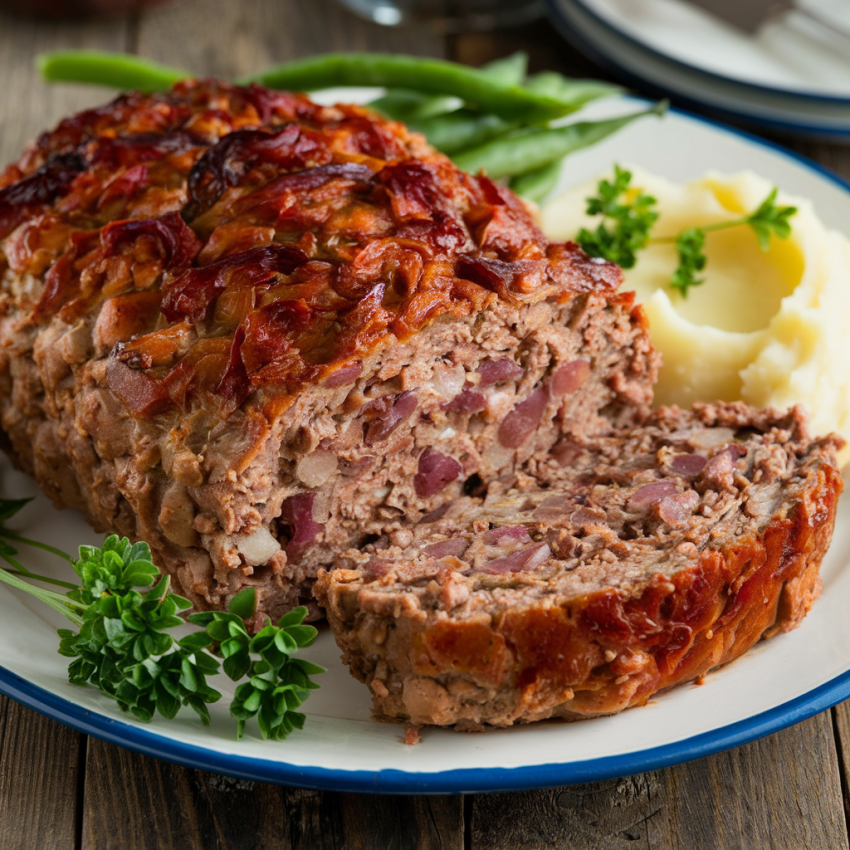What if I go through all this effort and it turns out dry and flavorless? I can already feel the disappointment on everyone’s faces.
You know that feeling—that pit in your stomach when you pull a dish out of the oven, and deep down, you already suspect it’s not quite right. You slice into it, hoping for something juicy and flavorful, only to be met with a crumbly, dry disappointment. The dreaded dry meatloaf. It’s not just about the food itself; it’s about the moment. The pause at the dinner table, the hesitant first bites, the polite nods that feel more like consolation than praise. That’s the real fear.
French onion meatloaf should be everything. Savory, rich, infused with the deep caramelized sweetness of onions and the melty decadence of cheese. It should feel like a warm, indulgent hug on a plate. But the thought of it turning into a rigid, dry brick instead? That’s enough to make anyone second-guess even trying.
So, let’s discuss it—why does meatloaf dry out, and more importantly, how do you prevent it from drying out?

The Real Culprit Behind Dry Meatloaf
First, let’s clarify: Dry meatloaf isn’t your problem. It’s a science problem. Ground meat is tricky. It needs moisture, but it also requires structure. Too much of one, and it falls apart. Too much of the other, and it turns into something that resembles an old sponge. And then there’s the cooking process—too hot, too long, or too lean of a meat choice, and you’re staring down a meatloaf that no gravy can save.
But here’s the good news: once you understand the why, you can fix it.
The Secret to Juicy, Flavorful French Onion Meatloaf
1. Pick the Right Meat (Fat is Your Friend!)
This is where so many people go wrong. The temptation? Lean ground beef. A 90/10 blend because it feels healthier. But here’s the thing—fat equals moisture. And when you cook a meatloaf, a good amount of that fat renders out. If you start with too lean beef, what’s left behind is… well, dry.
The fix? Go for 80/20 ground beef. Mix in some ground pork or veal if you want even more richness. It might feel indulgent, but that’s precisely the point. French onion meatloaf should be luxurious, not sad and crumbly.
2. The Power of the Panade
It will change your meatloaf game forever if you’ve never heard the word panade. A panade mixes starch (like breadcrumbs) and liquid (like milk or broth). It locks in moisture and keeps the texture tender instead of rigid.
For French onion meatloaf, consider using beef broth instead of milk—it enhances that deep, savory flavor we all love. And don’t skimp on it. A dry meatloaf almost always means not enough panade.
3. Caramelized Onions—But Done Right
Caramelized onions are the heart and soul of this dish, but they also bring moisture. The key? Don’t rush them. Onions cooked low and slow release their natural sugars and soften beautifully. If you try to speed up the process, you’ll end up with something more like sautéed onions—and that’s not the same.
Here’s a trick: Add a splash of beef broth or balsamic vinegar toward the end of cooking. It intensifies the flavor and adds even more moisture to your meat mixture.
4. Don’t Overmix the Meat
This one’s sneaky because it happens before the meatloaf goes in the oven. Overworking the meat mixture can lead to a dense, harsh texture, making dryness more noticeable.
The best way to mix? Use your hands. It sounds messy (because it is), but it combines everything without compacting the meat too much. Think of it like handling delicate pastry dough—you want to bring it together without crushing the air out of it.
5. The Cheese Factor (A.K.A. Built-In Moisture Insurance)
What makes French onion meatloaf different from regular meatloaf? Cheese. That gooey, melty layer in the middle isn’t just delicious—it’s functional. It adds moisture right where it’s needed most.
Swiss, Gruyère or even mozzarella work beautifully. Just place it in the center rather than mixing it throughout. That way, it stays melty instead of disappearing into the meat.
6. Low and Slow Wins the Race
High heat is the enemy. Cooking meatloaf too quickly causes the juices to escape before they can redistribute. Instead, bake at 325°F-350°F for about an hour (depending on the size). If you go much higher, you risk drying it out.
Bonus tip: A meat thermometer is your best friend. The magic number? 160°F. Anything beyond that, and you’re stepping into dry territory.
7. The Resting Rule
This is the hardest part, I know. You pull that gorgeous, bubbling meatloaf out of the oven, and every fiber of your being wants to slice into it immediately. But don’t.
Letting it rest for at least 10-15 minutes allows the juices to redistribute instead of running out when you cut into it. Think of it like steak—if you slice too soon, you lose all that precious moisture.
A Meatloaf Worth the Effort
Cooking isn’t just about following steps—it’s about how it makes you feel. The frustration of a dry, disappointing meatloaf isn’t just about the taste. It’s about the effort you put in, the anticipation, and the hope that it will turn out exactly as you imagined this time. It’s about wanting to see your family’s faces light up, to hear that first, genuine “Wow, this is amazing.”
And the truth? You can get there.
With the right balance of fat, a well-made panade, caramelized onions done right, and a little patience, your French onion meatloaf will be everything you hoped for—moist, rich, packed with flavor, and worthy of every bit of effort you put into it.
So the next time that little voice in your head whispers, What if it turns out dry?—you’ll know exactly what to do. And more importantly, you’ll know you won’t let it.
